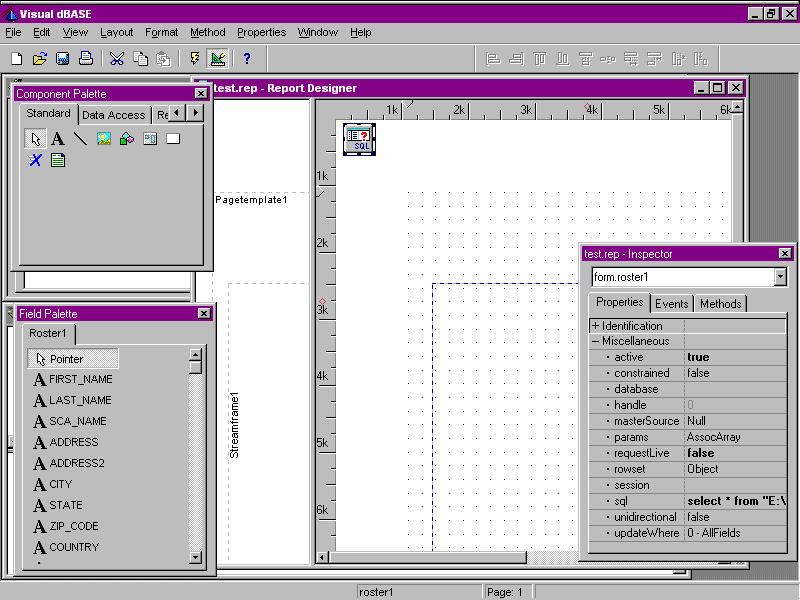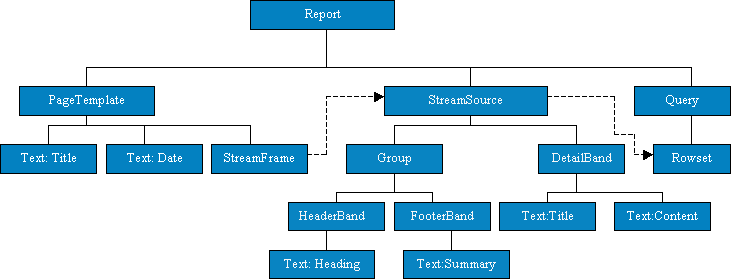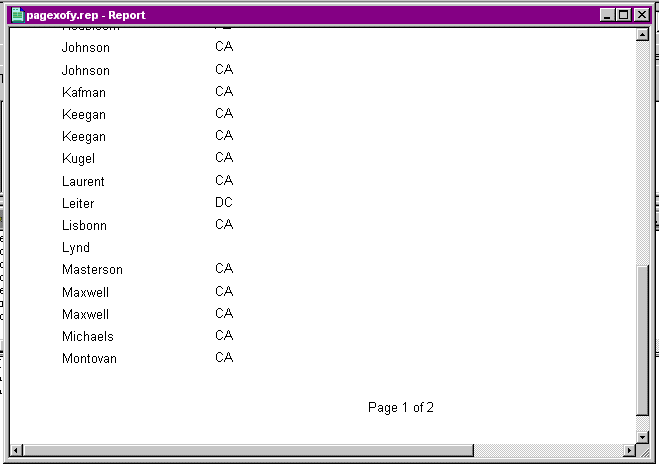When you are using the report designer, you will see a very busy screen, and this can be a bit confusing at first -- although if you've used the form designer you may be used to it, to an extent.
First, there are up to four palettes (which may be floating, they may be turned off, and so on). These are:
- The Inspector -- used to inspect and change properties and events;
- The Component Palette -- used to place specific controls onto your report;
- The Field Palette -- one method of placing fields (columns from the rowset(s)) onto the report;
- The Format Toolbar -- used to insert HTML formatting into your text controls.

In addition, there is the report designer itself -- this actually has two parts, although the default is to show just the report. These are called panes (it's a window) -- the pane on the left is called the Group pane, and the pane on the right is the Report pane. When you first open the report designer, there is a vertical bar on the left of the Report pane -- if you drag this bar to the right, you will see the Group pane.
The Group Pane shows the hierarchy of objects in the report down to the bands (it does not show controls). The Report Pane shows the report appearance with the corresponding structures shown in the Group Pane -- this uses live data.
Metrics
Some folks have discovered that it's easier to turn these off, and then to place
your own labels where you need them. This can be done by right clicking on the
field palette surface, and then select the "Customize Tool Windows ..." item
from the popup menu. In the dialog that appears, in the "Add field label" section,
select "None".
Next time you drag a field from the field palette, no label will appear. You then
can either place your own on the pageTemplate above the streamFrame, or anywhere in the detailBand, if that is your desire, and so on.
Alignment Tools
When you are in the report designer, in the toolbar (and in the "Align" menu),
are a set of toolbuttons designed to help you line up controls. To use this,
select two or more controls that you wish to line up (use <Ctrl> and the mouse to select them), and then you can line them up on the left, the right, top or
bottom. (You can also make your controls the same size -- height, width ...)
In addition, you can center controls horizontally in the band your
are working in (or the pageTemplate) by clicking on them and going to
the Layout menu, and selecting "Align" and then "Center Horizontally in
Window". (In most cases you probably don't want to "Center Vertically in
Window" ...)
Lines
Metrics
AutoSort
Autosort is used by the report designer to modify your query's SQL
statement, so that the data "automatically sorts" the way you need it
to. This can be useful in some cases, and in others it can be confusing.
What it does is add (or modify) the ORDER BY clause of the SQL SELECT
statement of the query.
There are cases where you really need the report to use your index tag(s),
and you would want to then turn autoSort off in your report.
Large Tables
To make this a bit quicker, you may find that you need to use a
little-known feature -- the ability to only display a single row.
This can be done by right-clicking on the surface of the report,
and in the popup menu, selecting "Report Designer Properties". In the
dialog that appears, you can then select the "One Row" radio button
in the middle of the dialog, and your report design can be sped up.
Caveat: this affects all reports -- so once you have completed your
changes, you may wish to go back and reset this property to "All Rows".
Navigating In Report Designer
Blank Fields
There are two simple solutions -- one is to add a "dummy" record that
will always sort at the top of the table -- if your key field (the one
you are indexing on) is numeric, set the value in this "dummy" record to 0,
if it is character, set it to something that starts with a space, etc. The
other fields in the "dummy record" should all contain data. Once you are
done, you can then delete this record ...
The second solution is to use a "dummy" table -- one with the exact same
layout as the real table, but in the designer you are working off this other
table which contains data in all the fields ... once your report is designed,
you can simply change the query's SQL statement to the real table.
Null Fields
This isn't a real problem unless you are creating calculated fields in your
reports that assume that there are values contained in the fields. If a
null value is added to a character string, rather than getting the character
plus the null value, you get simply a null value. This works for logical,
numeric, date, and character fields ...
The solution to this problem is to check for the null value. The following
is assuming your calculation is contained in the text property of the text control:
Now, the above is a bit complex to store in the text property, and you may
want to use the canRender event to do this instead (this is covered in the
section of this paper that discusses calculated fields).
A more simple method of doing this is to pass the value of the field
through the String class constructor (this converts nulls to empty strings),
which has the added advantage of typing the long object reference only once:
Displaying Numeric Values
For example, if you have data that must display two digits on the
right of the decimal, but in one calculation or field you have a value that
has zeros for the digits to the right, you may end up seeing an integer value
appear.
If you set a picture clause, you can get the value to always display two
digits on the right of the decimal (999.99, for example).
In addition, in some cases, you may want to display percent symbols and such --
you may want to use transform() (see online help for details) to get everything
to line up.
The default metrics for the report designer are twips, there are
1440 twips to the inch (a twip is a "twentieth of a point";
there are 72 points per inch). This, for people used to thinking
in inches, (or centimeters, or ...) can be a bit mind-boggling,
and trying to determine how wide a page is, or how far from the
left margin you wish to set an object, can be difficult at best.
As it turns out, and some of you reading this have probably
already found this, but sometimes what seems like it should be
obvious isn't ... you can change the report metrics for your
reports! If you think in inches, then by all means, change the
metrics for your reports to inches. The metric property is found
in the inspector for the 'form' -- if you are designing a report,
the form is the report -- and if you click on it, you will see
a combobox with several options: Chars; Twips (default); Points;
Inches; Centimeters; Millimeters; Pixels. Most people don't think
too clearly in anything but Inches, Centimeters or perhaps
Millimeters -- so you may want to get used to setting the metric
property as soon as you start designing a report (you could use
a custom report that set this and any other properties you
commonly change from the defaults for you ...).
Throughout this paper, I am using "inches" as my metric setting.
Some Hints ...
The more you work with the report designer, the more things you find that can
make it easier to work with. The following are hints from various sources
which may make designing your own reports easier:
Field Labels
Top/Menu
When designing your report, and dragging fields from the field palette, the
report designer places labels for each field onto the report. The default is
to place them above the field, and you can change this setting to the 'left' or
to simply not display them at all. Note that you get field labels in
reports, but not when designing labels.
When you are working in the design surface, getting your controls to line
up can be bothersome. You can do it the hard way -- going to the inspector
for one control, looking at the values, and then setting the same properties
for other controls; or you can use the alignment tools.
If you want to place a line between detailBands, there are some options, but
experimentation has shown that your best bet is to place the line at the top
of the detailBand, not at the bottom, or in the group headerBand or footerBand (if
you are using groups). This way, you always have the line at the top of the detailBand
for each row that prints ...
As noted elsewhere in this paper, setting your report metrics to a value that makes
sense to you is a good idea -- twips are hard to work with unless you're a typesetter.
Also as noted in the section of this paper on groups, you may wish to set the value
of this property (of the report itself) to false -- otherwise you may find your
report sorting in ways you didn't expect.
If you work with large tables in your reports, sometimes it takes a long
time to make even the most simple changes -- this is because the designer
is making these changes for each instance of the detailBand that is
generated for the report (remember, the report designer works with
live data).
If you are dealing with a large report, it is helpful to view data on
various pages. As it turns out, in the designer, you can see the next
page by pressing the <PgDn> key on the keyboard, and to
see the previous page, you can press the <PgUp> key.
If you've worked with the report designer for any length of time, you
will have noticed that if you have blank fields in the first few rows, but
want to use those fields in the report, they don't appear -- which makes
it difficult to manipulate them.
This is related to the "Blank Fields" topic -- if you are using DBF7 tables,
the BDE uses "true null" support. This means that a field that has not had a value
entered into it contains a null value. This can be quite confusing when you try to
generate a report, because the isblank() function is not going to return
"true", but the field doesn't appear to contain a value. Note that empty() does
return "true" in this case.
{|| trim( ;
iif( this.form.address1.rowset.fields["last name"].value ) == null, ;
"", this.form.address1.rowset.fields["last name"].value ) ) +", "+;
trim( ;
iif( this.form.address1.rowset.fields["first name"].value ) == null, ;
"", this.form.address1.rowset.fields["first name"].value ) ) }
{|| trim( new String( ;
this.form.address1.rowset.fields["last name"].value ) )+;
", "+;
trim( new String( ;
this.form.address1.rowset.fields["first name"].value ) ) }
Sometimes getting numeric values to display just the way you want them can
be a bit tricky. You should consider using the picture clause or the transform() function to make sure that your numeric values line up just right in your report.
Enhancing the Appearance of Your Reports
Reports can be pretty bland, so sometimes it is desirable to enhance the appearance a bit to make parts of the report stand out, and/or just make it look better or easier to read.There are a variety of things you can do to enhance your reports with very little effort:
- You can set the border property of the streamFrame to true, and experiment with the various borderStyles. (For a report with multiple streamFrames you might want to do this for all of them ...)
- You can set the border property of individual text controls, and again experiment with the borderStyles.
- You can set a rectangle around a group of information (and work with various borderStyles, colors for the rectangle ...). Be warned that on at least some printers, the rectangle appears correctly on screen, but when printed it gets off-set down and to the right of where it is in the designer (this bug has been reported to the developers). The best workaround to date is to use a Shape object, with the shapeStyle property set to 1 (Rectangle). This allows you to set colors and such, and the rectangle created this way does not do the offset when printed. (It also lets you create a rectangle with rounded corners, and gives the other shape options, as well.)
- You can set colors for various controls, and can even set conditional colors (for example, if a numeric value is negative, you could set it to red ... this could be done in the canRender event).
- Fonts can be used to change the appearance of parts of a report, or if you do not wish to use different fonts, you can work with the various properties to change the appearance of the text -- bold, underline, fontSize, and so on.
- Text controls on reports respect standard HTML formatting tags.
Example: <B>some text</B> means to boldface the text
'some text' -- and you can combine tags if you know them (there
is also a format toolbar that can be used to do this kind of
thing in the designer).
Some of the formatting options (Tags) that are useful to know about:
<B>Text</B> = Boldface the text between these tags
<I>Text</I> = Italicize the text between these tags
<U>Text</U> = Underline the text between these tags
<BR> = Break a line -- e.g., start a new line where this tag appears
(There appears is a very minor bug here, that causes the output to be a bit odd, but it's fixed by adding a space after the closing angle bracket of the tag.)
<P> = Paragraph break -- as above, but if you output your report to HTML, it includes a blank line
<Hn>Text</Hn> = Header size -- headers can be sizes 1 to 6, 1 is largest
<FONT SIZE=n>Text</FONT> = Font sizes from 1 to 7 -- default is 3, 1 is smallest, 7 is largest (close to H1)
<FONT COLOR='colorname'>Text</FONT> = Color of text can be changed. In addition the font size and color tags can be combined into one, by simply issuing: <FONT SIZE=n COLOR='somecolor'> ...</FONT>When you design these directly into your report, you can modify the text property along these lines:
"Some <B>text</B> to be <I>displayed</I>"
or, if you wanted to modify the appearance of a field from your table, you could add to the codeblock:
{|| "<FONT COLOR='red'>"+this.form.queryname1.rowset.fields["fieldname"].value+"</FONT>"}
There is a lot more, but you should examine the online help, as well as books on HTML ...
See sample file: "HTMLSAMP.REP"
Top/Menu

